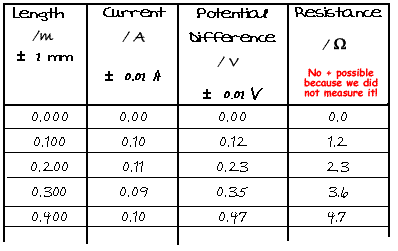|
|
|
Recording your results in a table

Neat
tables should always be used to present the results of your experiments.
There should
be a column for
- each
set of readings taken (never omit these!)
- each
set of calculated values from the experimental data (these may be
derived for you to calculate values or plot a graph)
Headings
should
- be
at the top of a column of numbers (this is preferable to on the
left of a series of results).
- give the
physical quantity measured in words (eg. current, potential difference,
length, time) . Abbeviations (I,
V, l, t) can be used only if it is clear what they stand for in
the text - it is best to include both! Do not use 'amount of' or
'quantity of'' - use 'volume' or 'mass'
- include the
unit the physical property is measured in. This should preferably
be the S.I. unit (as this is the one that will be required in calculations).e.g.
Current I
(A)
- have an indication
of the error involved in taking the reading (if applicable). This
can be given as a + value or percentage and indicates the
uncertainty you have in taking the measurement - the reading is
usually taken to about the nearest of a half a sale marking.
- have
border lines drawn around them.
Columns
should
- contain
only numerals (your units are at the top already.... it would be
a mistake to put them in again!)
- contain
numbers to the correct number of significant figures. This should
indicate the accuracy to which you can read the instruments you
have used. (e.g. 0.20 m indicates a reading taken to the nearest
cm whereas 0.2 cm indicates you can only read to the nearest 10
cm and 0.200 m to the nearest mm). Therefore a column representing
a set of readings taken with the same instrument should all have
the same number of significant figures.
- have
border lines drawn around them

Word-processing
results can lead to errors. You should be very careful to check your
final draft carefully
Common
errors that lose you marks:
- Using
the wrong font: remember the symbol allows you to put in greek letters
such as
 , ,  , and , and  . .
- Puting
numbers in to the wrong number of significant figures (especially
if worked out on a spreadsheet without thought to formatting the
numbers in the column.
- Missing
out the columns with readings taken - only including columns needed
to calculate the conclusion value or plot a graph is a major error
- you must include the columns of results you took during the experiment!
- Incorrectly
calculated derived values because you have put in the wrong formula
- always check at least two values in a 'fill down' column with
your calculator!
- Not
drawing a border - making it a list of numbers not a table of results.
L O Jones
(October 2001) |
|

Follow me...




|


